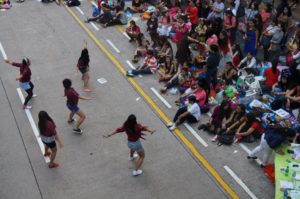
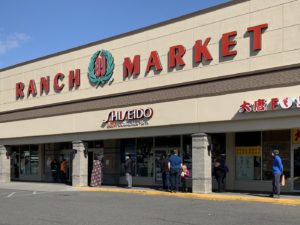
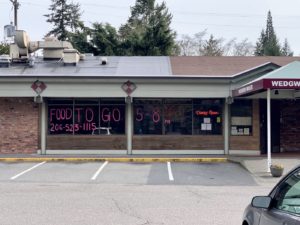
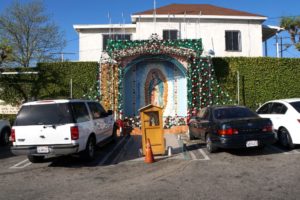
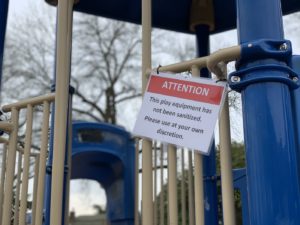
Since late January this year, life in Seattle has steadily descended into an unsettling and uncharted reality, like many other cities around the world. On January 21, the first coronavirus case in the United States was confirmed in Snohomish County, less than forty minutes away from the city center in Seattle by driving. On January 26, we received an email from the University of Washington (UW) where I teach saying that three students returning from Wuhan were being screened for the novel coronavirus.[1] By the next morning, facial masks and hand sanitizers were sold out at stores in the University District.
On March 2, fourteen new coronavirus cases, including five deaths, were reported in King County. A petition began circulating among our students demanding the university to close its campuses. On March 6, UW became the first university in the country to end all in-person classes effective March 9, a week before Spring break would begin. Later that day, a staff member was tested positive for COVID-19, and so was a resident in a senior home located in my very own neighborhood.
By March 11, the number of confirmed cases in the state climbed to 374. The Seattle Public School announced that all schools would close for a minimum of 14 days starting the next day. Seattle Public Library also soon announced that all locations would be closed until at least April 13. On March 23, Governor Jay Inslee issued a “Stay Home, Stay Healthy” order that required Washington residents to stay home and all businesses to close except those deemed essential. Local buses in King County also began to operate with reduced service.
By this very moment, at the end of March, any semblance of normalcy in this West Coast boomtown has long been lost. Picnic shelters, public pools, playgrounds, community centers, and state parks are closed indefinitely. Some restaurants, bakeries, and cafes are still open but offer only take-out services or deliveries. Social or physical distancing is now practiced religiously with pedestrians walking on different sides of the streets to avoid passing each other. Like elsewhere in the country, shoppers are asked to wait outside grocery markets if the space becomes too crowded. The line can stretch to hundreds of feet as people keep a distance from each other, six feet apart.
Life and Public Space Unsettled
The disruptions in public life and access to public space in Seattle, and other cities around the world, are unprecedented, at least in our memory. The pandemic has upended how urban spaces have functioned and performed historically and in contemporary time, from the way we moved around the city to how commerce and daily life are conducted, not to mention the basic services that have been taken for granted. We are waking up to a new reality that others in Asia and Europe have experienced earlier in the pandemic.
Of all the services and amenities we have assumed to be essential in urban life, the loss of public life is perhaps the strangest and most unsettling to experience. Compared to other more severely impacted cities, here in Seattle, we can still buy groceries in local supermarkets, order supplies online to meet our basic needs, and even take a walk in the neighborhood. Though children are staying home without schools, we have gotten somewhat used to this whenever there are snow days. With businesses closed, the loss of jobs is causing pain and suffering for many families and individuals. However, this is not the first time, nor the last time, in an economy that goes through cycles of booms and busts. In contrast to these life adjustments, the changing norms in public space are probably the least familiar and require more getting used to.
While many of us may find this limited form of public space to be strange and unsettling, it’s important to point out this experience is not entirely new to many members of our society. The parks and playgrounds that we enjoy in our neighborhoods are not available or equally maintained in many other communities. For some members of our society, accessing public space may even carry the risk of arrest and harassment if one fits a particular profile. For some of us, public space may simply be a space to get from one point to another. For others, such as street vendors, it may be critical to their livelihood. The loss of access to public space represents the loss of income or even the end of a lifeline.
The Not-So-Public Public Spaces
Public space as we know it has never been fully accessible and open to all. In the United States, racial segregation meant that not all spaces were accessible by everyone. Through much of the Twentieth Century, for example, many black Americans were denied access to public libraries (Knott 2016). The structural barriers continued albeit in different forms. In New York City, with the practice of stop-and-frisk, over a million young people have been stopped by police between 2010 to 2014 alone, mostly Black and Latinx. Nearly nine out of ten stopped-and-frisked New Yorkers were completely innocent. The practice rendered the city’s public space unwelcoming to an entire age group in particular communities.
The book Variation on a Theme Park, edited by Michael Sorkin (1992)(who passed away on March 26, 2020, after contracting the coronavirus) was one of the first to critique the diminishing forms of public space due to growing privatization and the imperative of safety and security. In his chapter in the book, Mike Davis characterizes downtown Los Angeles at the time as a militarized space in a war against the homeless and the others. In another chapter, Christine Boyer (1992: 95) depicts the transformation of Times Square in New York City as “a purified complex of commerce and culture” that destroyed the “fragile remnants of the incongruous and the unusual.”
While the conditions of cities today may have evolved considerably since the 1990s, many of the biases against certain social behaviors are still engrained in our legal system, policing practices, and even patterns of urban development. Arrests for loitering and vagrancy, for example, have often been associated with racial profiling. The Black Lives Matter movement reminds us that much work remains to be done to address racial and spatial justice in our society. Gentrification and displacement (losing beloved places in the neighborhoods) are now common challenges in many communities. The populations experiencing homelessness lose not only their homes but also in many instances their right to access the public space.
Creative Practices in Times of Crisis
While public space historically has not been equally accessible to all members of the society, the subaltern groups have found ways to get around it, by engaging in various forms of creative spatial practices to circumvent these obstacles. In East Los Angeles, for instance, without the resources to engage or invest in large-scale changes, residents transform front yards and parking lots into spaces of socialization, worship, and even business (Rojas 2010). In Beijing, lacking access to parks and formalized open spaces, rural migrants perform dances in parking lots and other residual spaces in the city to entertain themselves and the passersby (Chen 2010).
In Hong Kong, migrant workers occupy the city’s financial district in Central in sheer magnitude and transform the corporate spaces into places of carnivalesque gatherings weekend after weekend, reversing the relationship of hosts and guests and challenging the assumptions about who make the city (Tam 2016). In Taipei, illegal street vendors help each other out by pooling money to pay the fines when they get caught and thereby lowering the risk of doing business in place when vending is not allowed. They would also help each other guard against approaching police officers (Hou 2016).
Amid the COVID-19 crisis, we have witnessed similar kinds of creative acts to overcome social isolation and to meet the needs of the community. Neighbors signing and performing together on apartment balconies in Italy stood out as a memorable example. Virtual or digital happy hour has enabled socialization among those with access to the Internet. In Seattle, virtual community forums have popped up in place of in-person meetings. There was also a Virtual Civic Cocktail organized to engage the public on issues facing the region. In the absence of physical space, cyberspace provides a temporary refuge for public life.
There were also other kinds of efforts like that by Yadesa Bojia, a Seattle-based artist and University of Washington graphic designer. Concerned about the lack of information and knowledge in his immigrant community, Bojia started a live video on social media to read the recommendations from the Center for Disease Control and Prevention to the community in Amharic. Facing the decline of businesses in Seattle’s Chinatown International District due to racist fear, Bill Tashima, a community leader, created a social media group to share ways to support small businesses. Within days, nearly 5,000 people joined the group, “sharing ideas for restaurant takeout to boost business.”
Elsewhere, volunteers and delivery drivers are helping others by deliveringfood and essential supplies to those in need and cannot go far. Facing the shortage of PPE (Personal Protection Equipment), makers and volunteers around the world have geared up to produce face shields and other supplies using CNC routers, laser cutters, and other tools they can find. Volunteers have sewing masks for hospitals to use as a last resort. Some have even attempted to fabricate DIY ventilators to help meet the demand.
With the built environment community, several initiatives have emerged in recent times. Inspired by similar efforts in other disciplines, a Sick Faculty Lecture Exchange was created to facilitate support among architectural historians. Similarly, there is also an online spreadsheet called Virtual Final Review Participation that enables volunteers to sign up if they can participate in online studio reviews to support their colleagues. A number of us with a focus on community design have taken a step further by creating the Distance Collaboration Commons (disCO-commons) to support the sharing of online resources and collaboration among educators engaged in design for social change.
Public Realm after COVID-19?
These acts of solidarity and mutual support, including both those currently happening around the world and those that have long been performed by marginalized social groups in their everyday life, suggest ways we can overcome the social isolation and address many urgent needs in the struggle to flatten the curve. In a webinar hosted by ACSA (Association of Collegiate Schools of Architecture) to discuss challenges facing online instructions for classes on community engagement and design/build, Bob Shibley, Dean of the School of Architecture at the University of Buffalo, suggested that we need to move beyond public space as an artifact and consider instead the notion of citizenship in the face of our current crisis.
Indeed, if we can think of public spaces and public life as constituted by people through their generous and selfless acts, we can surely find creative ways to construct relationships and build community in this extraordinary moment in time. Despite the constraints of shelter in place and social distancing, there are ways for us to leverage what we still have in terms of material and human resources to address the crisis at hand. More than anything, these creative acts remind us of our individual and collective ability to shape the public realm, to redefine or perhaps rekindle our relationships to each other as communities and citizens, and as members of the society.
Under COVID-19, the struggles for public space has become a shared experience by both the haves and have-nots, the privileged and the less privileged. Though the actual experiences can vary dramatically among the diverse social groups, reflecting the persistent social divide even under the pandemic, the sense of isolation and deprivation is something we can find in common. The inability to access the basic functions of the cities, including public space, is no longer a reality experienced only by the marginalized social groups.
As we hopefully would overcome the pandemic one day, let’s remember the strange and unsettling experiences we are encountering at this moment. When life returns to the norm again, if there ever was one, let us lend our support to those for whom this experience of isolation and deprivation has long been a part of their daily struggle. Let’s find ways to overcome the barriers that exist far beyond the six feet of space.
References
Boyer, C.M. (1992). Cities for Sale: Merchandising History at South Street Seaport.” In M. Sorkin (Ed), Variations on a Theme Park: The New American City and the End of Public Space, pp. 181–204. New York: Hill and Wang.
Cahill, C. Stoudt, B.G., Matles, A. Belmonte, K., Djokovic, S., Lopez, J., Pimentel, A., Torre, M.E., & X, D. (2017). The Right to the Sidewalk: The Struggle Over Broken Windows Policing, Young People, and NYC Street. In J. Hou, & S. Knierbein, (Eds), City Unsilenced: Public Space and Urban Resistance in the Age of Shrinking Democracy, pp. 94–105. London and New York: Routledge.
Chen, C. (2010). Dancing in the Street of Beijing: Improvised uses within the urban system. In J. Hou (Ed), Insurgent Public Space: Guerrilla Urbanism and the Remaking of Contemporary Cities, pp. 21–35. London and New York: Routledge.
Davis, M. (1992). Fortress Los Angeles: The Militarization of Urban Space. In M. Sorkin (Ed), Variations on a Theme Park: The New American City and the End of Public Space, pp. 154–180. New York: Hill and Wang.
Hou, J. (2016). Everyday Urban Flux: Temporary Urbanism in East Asia as Insurgent Planning. In M. Chalana, & J. Hou (Eds), Messy Urbanism: Understanding the “Other” Cities of Asia, pp. 193–214. Hong Kong: Hong Kong University Press.
Knott, C. (2016). Not Free, Not for All: Public Libraries in the Age of Jim Crow. Amherst, MA: University of Massachusetts Press.
Rojas, J. (2010). Latino Urbanism in Los Angeles: A model for urban improvisation and reinvention. In J. Hou (Ed), Insurgent Public Space: Guerrilla Urbanism and the Remaking of Contemporary Cities, pp. 36–44. London and New York: Routledge.
Sorkin, M. (Ed) (1992). Variations on a Theme Park: The New American City and the End of Public Space. New York: Hill and Wang.
Tam, D. (2016). Little Manila: The Other Central of Hong Kong. In M. Chalana, & J. Hou (Eds), Messy Urbanism: Understanding the “Other” Cities of Asia, pp. 119–135. Hong Kong: Hong Kong University Press.
Jeffrey Hou is a professor of landscape architecture at the University of Washington, Seattle, where he directs the Urban Commons Lab. His work focuses on engaging marginalized communities and citizens through community design, design activism and cross-cultural learning.


